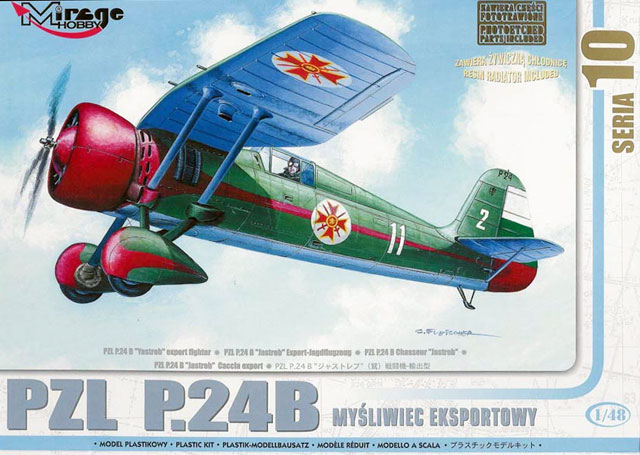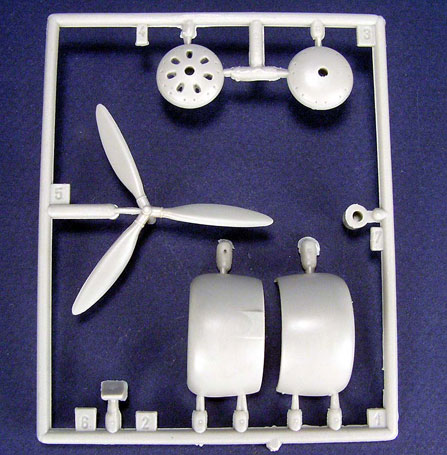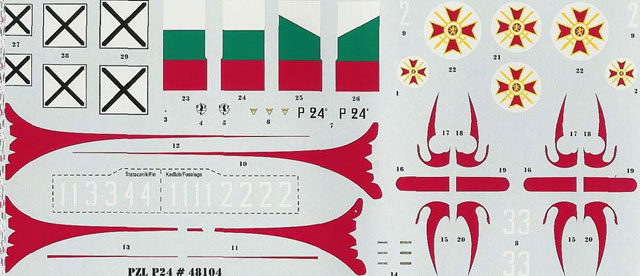|
PZL P.24B

Mirage Hobby, 1/48
S
u m m a r y
|
| Catalogue Number: |
48104 |
| Scale: |
1/48 |
| Contents and Media: |
68 parts in grey styrene, 6 parts in
cream colored resin, etched brass, film for instruments and 2 parts in
clear injection molded. Instructions and decal sheet for three aircraft. |
| Price: |
USD$22.46
online from Squadron.com |
| Review Type: |
FirstLook |
| Advantages: |
A fine rendering of the PZL P.24
with good wing surface detail. |
| Disadvantages: |
|
| Recommendation: |
Highly Recommended |
Reviewed by
Steven "Modeldad" Eisenman

Mirage Hobby's
1/48 scale PZL P.24B is available online from Squadron.com
This might be the easiest review I have ever written,
as all the real work has been done by Mike Dobrzelecki in his excellent and
comprehensive
review of the previously issued F and G models of this aircraft. It is
a must read. He has also has written a most excellent
review
of the PZL P.11C.
There are, however, some difference between the
Bulgarian B model and the F and G model used by the Greeks. While nearly
all the plastic sprues are the same, the B model has a different cowling,
engine face and propeller and differently styled shell ejection ports, which
are nicely done in resin.

Click the
thumbnails below to view larger images:
There is one odd aspect to this kit, and that is the
clear parts. You get a windshield and a clear top part. But, pictures I
have seen of Bulgarian P.24Bs show that if the top cover was in place, there
were windows extending from the rear of the cockpit about a third of its
length.

These windows are not in the kit. However, it would
not be difficult at all to cut them from clear stock. Although the painting
guide shows the top cover in place, I have the feeling this was frequently
removed in practice.
Bulgaria received 12 P.24Bs and they were divided among
three Squadrons (“Yato”), Numbers 1, 2 and 3, with apparently four aircraft
per squadron. Bulgaria placed the squadron number on the side of the
fuselage in a doubling of the squadron number. So, an aircraft in No. 1
Squadron carried the number 11 on the fuselage, 22 for 2 Squadron and 33 for
3 Squadron. The individual aircraft number was on the fin. There are
specific markings for the number 2 aircraft of the 3rd Squadron.
But the decals come with sufficient numbers to allow you to represent any
aircraft in any squadron.
Decals are provide for the colorful red stripe down the
fuselage, which you will need to match in painting the cowl. There are also
decals for the design on the wheel covers. In fact, there are two sets of
wheel cover decals; for another aircraft or for the proverbial mistake and
messed decal.

Click the
thumbnails below to view larger images:
There are two types of national markings. One for the
pre-war to early war royal markings with the Maltese style cross and crossed
swords and the war-time black St. Andrews cross in a white box. There are
also tri-color rudder stripes in two styles.
If you have the
Kagero monograph on the P.24 A-G (which I recommend, if you interested
in this aircraft), then you have additional markings available. That
monograph comes with a set of decals that allow you to do the markings on
the aircraft that was specially painted to honor the birth of the royal heir
on 27 June 1937. The aircraft carries the words “Simeon Kniaz Trnowski”
down the side of the fuselage.
As for the color of the Bulgarian PZL P.24B, they were
all simply painted in dark olive-green top side with light blue underside.
The dividing line between the two colors appears quite hard edged.
I have built the Mirage PZL P.11C, and while clearly not shake and bake, it
was an enjoyable build. I expect the same from this P.24. I also must note
that I have had good customer service from Mirage. I found a main wing
strut was not properly molded in one of the P.11C kits. An email to them
resulted in a set of new struts in a reasonable amount of time. A lot to be
said about a company that puts its phone, fax and email on the side of the
box.
I highly recommend this kit, not only because of the
quality of the product, but also because it is good to have available models
of less well known aircraft of the minor combatants of World War 2. This is
something that modelers should support.
Highly Recommended.
Thanks to Squadron.com
for the review sample
Review and Images Copyright © 2004 by
Steven "Modeldad" Eisenman
Page Created 17 November, 2004
Last updated 17 November, 2004
Back to HyperScale Main Page
Back to Reviews Page
|
Home | What's
New | Features
| Gallery |
Reviews | Reference
| Forum
| Search